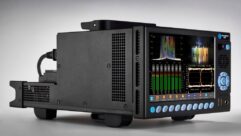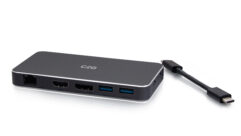
HD Technology Trends
Apr 1, 2006 12:00 PM,
By Jay Ankeney
New advances will push HD images into the corporate world.
Sony PCS-HG90
With more than 20 million HDTV screens sold to the domestic home market by end of 2005, most of us have experienced the advantages of high-definition television. But in the corporate enterprise communications arena, HD has been a hard sell until recently. After all, large standard-definition screens have been commonplace for so long in corporate boardrooms, training centers, digital signage installations, and even lobby displays that we have all become accustomed to them. Presentations needing really fine detail have usually been shown on computer-generated VGA screens (at least since IBM introduced the Video Graphics Array resolution standard in 1987).
Now that SXGA resolutions of 1280×1024 and higher are readily available on even modestly priced laptops, most designers and technicians already work with data-dense screen displays. More importantly, since standard-definition video infrastructure already exists, why should a corporation make the upgrade? The broadcast networks were forced to take the plunge into digital transmission by FCC mandate, but until recently corporations had been facing massive capital outlays if they wanted to catch up.
With recent developments in codecs, disk and hard drive storage, and digital signage systems, however, all that is changing. This Technology Trends article looks at some of the new technologies that will soon enable HD to spread its gloriously dense images and crystal-clear audio throughout corporate America, educational institutions, houses of worship, and anywhere people need to see what only high-definition pictures — and their associated multichannel digital audio — can convey.

JVC SRDVD-100U
THE ROAD TO HD
On Dec. 24, 1996, the FCC began the process of mandating all over-the-air broadcasters to switch their signals to digital by adopting the major elements of the Advanced Television Systems Committee (ATSC) digital television standard A/53 for the nation’s next generation of broadcast television. The date for the changeover became a moving target as manufacturers and consumers balked at the confusion that resulted from this decision, but finally a bill signed into law on Feb. 8, 2006, set Feb. 17, 2009, as the completion date for this transition.
This actually just stipulates that the analog spectrum will be reallocated, and broadcasters will have to begin sending out a digital signal using MPEG-2 compression, a video and audio encoding standard developed by the Motion Picture Experts Group. Although legally the networks have to provide only a digital version of the kind of images we see today (standard definition), in the public’s mind this has been inextricably linked to high definition.
HD IN THE BOARDROOM
Terrestrial broadcasters are currently committed to MPEG-2 compression for their transmission, but a whole new animal called MPEG-4 makes it possible for existing corporate infrastructures built for standard-definition transmissions to carry high-definition images as well. MPEG-4 was introduced in 1998 and has become the compression scheme of choice for streaming media and, increasingly, digital content creation systems. Since MPEG-4 can squeeze the uncompressed HD signal from around 1.5Gbps down to hundreds of kilobits per second if needed, highly compressed digital signals can be sent over Internet Protocol infrastructures (IPTV). This provides the magical gateway most corporations need to adopt inhouse HD communications.
But as promising as MPEG-4 seems, it is not free. MPEG-4 is patented proprietary technology and, much to the delight of intellectual property lawyers everywhere, patents covering MPEG-4 are claimed by more than two dozen companies. For example, AT&T says that it possesses several patents related to essential components of the MPEG-4 video technology and, as a result, just last Feb. 14 fired off warning letters to companies including Apple, CyberLink, DivX, InterVideo, and Sonic Solutions claiming they are using its MPEG-4 technology without a license.

Canopus MediaEdge
One of the most popular digital video codec standards for MPEG-4 is referred to as H.264/AVC, or sometimes just AVC for Advanced Video Coding. It was written by the ITU-T Video Coding Experts Group (VCEG) together with the ISO/IEC Moving Picture Experts Group as the product of a collective partnership effort known as the Joint Video Team (JVT). The vendors of H.264/AVC products and services are expected to pay licensing royalties for the patented technology that their products use. Still H.264, just completed in May of 2003, is rapidly being deployed in new technologies that will affect the pro AV marketplace.
Another compression technology that will affect HD delivery over IP is a new recording technology called HDV. The HDV format was developed by four companies — Canon, Sharp, Sony, and JVC — to record a compressed MPEG-2 HD signal on a MiniDV cassette using a bandwidth of just 19Mbps to 25Mbps. Not only has HDV technology brought high-definition field cameras down to the price range of standard-definition cameras, but new implementations in disc recording technologies are going to put HDV at the forefront of HD delivery systems for corporations as well.
One of the systems that uses HDV but not H.264 is MediaEdge from Canopus, a company specializing in advanced codecs that was acquired by Thomson last year. MediaEdge is a multichannel, multi-location video delivery system based on HDV recording on Windows platforms using existing TCP/IP networks for both standard-definition and HD display devices. The MediaEdge-SVS3 server software features several applications responsible for overall content management and server configuration, as well as utilities for controlling and updating MediaEdge-STB3 set-top boxes or client PCs running the MediaEdge-SWT3 software client. In addition, the MediaEdge-SWT3 software client functions as a web browser plug-in allowing any PC connected to the MediaEdge network to download streaming content from the Internet.
In May, Sony Electronics will be releasing its own brand-new codec, the PCS-HG90, as part of its new HD Visual Communications system. The PCS-HG90 codec, combined with Sony’s new PCSA-CHG90 PTZ camera, can transfer HD-resolution video and stereo audio over an IP network and will even be able to handle resolutions up to 1280×720p60, making it the first videoconferencing system that can provide 60fps scanned progressively. The PCS-HG90 codec supports the H.264 HD video protocol and a network video transfer bandwidth of up to 8Mbps. Sony’s HD visual communications system can also deliver MPEG-4 AAC stereo audio up to 22KHz, with stereo echo-canceling capabilities for improved video-conferencing audio.
The missing link for effective use of high definition in enterprise communication, however, has always been the lack of disc sources that could play back a recorded HD signal without breaking the budget. Previously, high-definition encoders and tape decks have been prohibitively expensive and difficult for many IT departments to use. DVD discs have been masquerading as “enhanced-definition” sources for many large-screen displays, but they pale in comparison to true HD content. So far, only Apple has provided a cost-effective desktop option for burning HD discs — the DVD Studio Pro 4 module of its Final Cut Studio suite of software — but those could only be played back on similarly equipped Macintosh G5 computers.

Grass Valley Turbo
On the consumer side, widespread HD disc playback has been delayed by the titanic format war between the rival Blu-ray and HD-DVD camps. Although the debate has been scorned by many as another Beta/VHS debacle, we may finally be seeing light at the end of that tunnel. In March, LG Electronics announced it was dropping plans to introduce its first Blu-ray-only player, the BD199 that it was displaying at CES, but said it might be the first to produce a player that could handle discs in either format. LG has signed an HD-DVD patent-sharing agreement with Toshiba, and may unveil its first Blu-ray/HD-DVD combo player as early as this fall.
JVC already has a disc-based high-definition distributing system called the SRDVD-100U ProHD media player, which can present true HD recordings in a variety of file formats including HDV files and Windows Media Video (WMV9). The SRDVD-100U is a disc reader that uses an internal standard red-laser DVD player. This means that MPEG-2 files created with HDV camcorders can be saved onto a common recordable DVD disc using any compatible DVD MPEG-2 file recorder, and then played back on the SRDVD-100U. The player also comes equipped with a standard RJ-45 jack for IP network connectivity that allows for network file playback with an IP address automatically assigned under DHCP. The SRDVD-100U comes with AveL Link Server software, which enables multiple players to play back files from a single server. The SRDVD-100U ProHD media player was co-developed by JVC and I-O Data and is distributed exclusively by JVC.
The Grass Valley business division of Thomson offers the Turbo disk recorder as an HD content source provider for pro AV installations, calling it an iDDR (intelligent digital disk recorder) or, sometimes, a TiVo on steroids. Turbo is capable of storing more than 40 hours of HD and SD video, bringing it in directly as HDV via FireWire from Sony or JVC cameras, or as file formats such as WMV, WMV-HD, QuickTime, or MPEG-2 video via the 100/1000Base-T Ethernet port connected to any network, the Internet, or its USB port. Based on Grass Valley’s experience with its Profile broadcast disk recorders, Turbo is compatible with all Macintosh or Windows computer file formats, including PowerPoint.
One of the most robust advanced codecs for HD is the DN×HD format from Avid Technology, whose edit systems are used on 90 percent of prime-time programming. Now this Avid codec is being incorporated into Omneon’s line of servers. As of this month, any Omneon Spectrum media server will be able to record and play back DN×HD files using Avid’s DN×change rack-mounted I/O device. Available just last January, Avid DN×change enables professionals to convert high-definition images to Avid DN×HD media so they can be transported anywhere in a facility over a standard-definition SDI network.

Omneon Spectrum-HD
The addition of the DN×HD codec to the range of HD formats supported by Omneon follows the recent announcement of the Spectrum’s ability to ingest and play back HDV material. Support for HDV will also allow users to ingest HDV material into a Spectrum server from Apple’s Final Cut Studio software. For playback, the HDV content is automatically scaled to a full 1920-line HD signal, which will allow native HD material and HDV material to be mixed on a single timeline for back-to-back playout.
MPEG Progression
The whole numerology of MPEG can be a bit confusing, although everyone with a teenager who likes rock and roll has been inundated with MPEG whether they know it or not. All those MP3 music files, and increasingly video programming, are part of the MPEG story, which dates back to the early ’90s. Let’s run some numbers just to put it in context. MPEG-1 was the first compression standard. It was used mostly for video CDs, but its audio layer 3, more commonly referred to as MP3, became a popular digital audio encoding and lossy compression format for downloading music files. MP3 was standardized in 1991 by a team of engineers directed by the Fraunhofer Society in Germany, who released its first MP3 software encoders in July 1994. That’s also the year MPEG-2 was published as the ISO/IEC 13818 international standard for digital video applications.
Then came MPEG-3, which was intended for HDTV transmissions until everyone discovered MPEG-2 could be tweaked to do the job just fine and dropped MPEG-3 entirely.
For More Information
Apple Computer
www.apple.com
Avid Technology
www.avid.com
Canopus
www.canopus.com
LG Electronics
www.lgcommercial.com
Omneon
www.omneon.com
Sony Electronics
www.sony.com
Thomson
www.thomsongrassvalley.com









